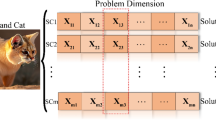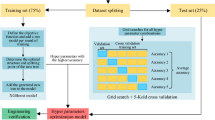Abstract
The aim of this study is to investigate the influence of rock variability on the failure mechanism and bearing capacity of strip footings. A probabilistic analysis of the bearing capacity of footings on rock masses is conducted in this paper, where random adaptive finite-element limit analysis (RAFELA) with the Hoek‒Brown yield criterion and the Monte Carlo simulation technique are combined. The stochastic bearing capacity is computed by considering various parameters, such as the mean values of the uniaxial compressive strength of intact rock, Hoek‒Brown strength properties, coefficient of variance, and correlation lengths. In addition to the RAFELA, this study introduces a novel soft-computing approach for potential future applications of bearing capacity prediction by employing a machine learning model called the eXtreme Gradient Boosting (XGBoost) approach. The proposed XGBoost model underwent thorough verification and validation, demonstrating excellent agreement with the numerical results, as evidenced by an impressive R2 value of 99.99%. Furthermore, Shapley's analysis revealed that the specified factor of safety (FoS) has the most significant influence on the probability of failure (PoF), whereas the geological strength index (GSI) has the most significant effect on the random bearing capacity (μNran). These findings could be used to enhance engineering computations for strip footings resting on Hoek‒Brown rock masses.



















Similar content being viewed by others
Data availability
No datasets were generated or analysed during the current study.
Abbreviations
- B :
-
Width of strip footing
- N :
-
Bearing capacity
- N det :
-
Deterministic bearing capacity
- N ran :
-
Random bearing capacity
- Q :
-
Ultimate vertical force
- q u :
-
Ultimate vertical pressure
- \(\sigma\) ci :
-
Uniaxial compressive strength of intact rock
- GSI :
-
Geological strength index
- m i :
-
Hoek and Brown yield parameter
- D :
-
Disturbance factor
- \(\mu\) :
-
Mean value
- \(\sigma\) :
-
Standard deviation
- COV :
-
Coefficient of variation
- \(\mathit\Theta\) :
-
Spatial correlation length
- r s :
-
Subsample ratio
- \(\Omega ({f}_{k})\) :
-
Regularization term
- \({\widehat{y}}_{k}\) :
-
XGBoost model's prediction
- \(\nu\) :
-
Learning rate
- \({Obj}_{(k)}\) :
-
Loss function
- λ :
-
Regularization factor
- R2 :
-
Coefficient of determination
- RMSE:
-
Root mean squared error
- SHAP:
-
SHapley Additive exPlanations
References
Ali A et al (2017a) Probabilistic stability assessment using adaptive limit analysis and random fields. Acta Geotech 12(4):937–948
Ali A, Lyamin AV et al (2017b) Undrained stability of an unlined square tunnel in spatially random soil. Geo-Risk 2017 [Preprint]
Ali A, Lyamin AV et al (2017c) Undrained stability of a single circular tunnel in spatially variable soil subjected to surcharge loading. Comput Geotech 84:16–27
Brahmi N et al (2018) Probabilistic analysis of the bearing capacity of inclined loaded strip footings near cohesive slopes. Int J Geotech Eng 15(6):732–739
Breiman L et al (2017) Regression trees. Classification And Regression Trees pp 216–265
Bharti JP et al (2021) Slope stability analysis using RF, GBM, CART, BT and Xgboost. Geotech Geol Eng 39(5):3741–3752
Chen T, Guestrin C (2016) ‘XGBoost’, Proceedings of the 22nd ACM SIGKDD International Conference on Knowledge Discovery and Data Mining [Preprint]
Cho SE (2012) Probabilistic analysis of seepage that considers the spatial variability of permeability for an embankment on Soil Foundation. Eng Geol 133–134:30–39
Dessi D et al (2023) Bow slamming detection and classification by Machine Learning Approach. Ocean Eng 287:115646
Dong X, Guo M, Wang S (2023) Inclination prediction of a giant open caisson during the sinking process using various machine learning algorithms. Ocean Eng 269:113587
Fathipour-Azar H (2021) Data-driven estimation of joint roughness coefficient. J Rock Mech Geotech Eng 13(6):1428–1437
Fenton GA, Griffiths DV (2003) Bearing-capacity prediction of spatially random c – ϕ soils. Can Geotech J 40(1):54–65. https://doi.org/10.1139/t02-086
Griffiths DV, Fenton GA (2001) Bearing capacity of spatially random soil: The undrained Clay Prandtl problem revisited. Géotechnique 51(4):351–359
Griffiths DV, Fenton GA, Manoharan N (2002) Bearing capacity of rough rigid strip footing on cohesive soil: Probabilistic study. J Geotech Geoenviron Eng 128(9):743–755
Halder K, Chakraborty D (2020) Influence of soil spatial variability on the response of strip footing on geocell-reinforced slope. Comput Geotech 122:103533
Hamouma D, Messameh AA, Tallah N (2022) Probabilistic analysis of lateral bearing capacity of pile-soil system. Int J Geotech Eng 16(5):525–531
Hoek E, Brown ET (1980) Empirical strength criterion for rock masses. J Geotech Eng Div 106(9):1013–1035
Hoek E, Carranza-Torres C, Corkum B (2002) Hoek–Brown failure criterion—2002 edition. In: Proceedings of the North American rock mechanics society meeting in Toronto, Canada
Huang J, Lyamin A, Griffiths D, Sloan S, Krabbenhoft K, Fenton G (2013) Undrained bearing capacity of spatially random clays by finite elements and limit analysis. Proceedings of the 18th ICSMGE: 2013 Paris
Jitchaijaroen W, Duong NT, Lai VQ, Sangjinda K, Nguyen TS, Keawsawasvong S, Jamsawang P (2024) Probabilistic analysis of the seismic bearing capacity of strip footings using RAFELA and MARS. Geotechn Geol Eng
Kasama K, Whittle AJ, Kitazume M (2019) Effect of spatial variability of block-type cement-treated ground on the bearing capacity of foundation under inclined load. Soils Found 59(6):2125–2143
Kasama K, Zen K (2010) The reliability assessment for slope stability considering the spatial variability of soil strength using random field numerical limit analyses. J Soc Mater Sci Jp 59(5):336–341
Keawsawasvong S, Thongchom C, Likitlersuang S (2020) Bearing capacity of strip footing on Hoek-brown rock mass subjected to eccentric and inclined loading. Trans Infrastruct Geotechnol 8(2):189–202
Krabbenhøft K, Lyamin AV, Sloan SW (2007) Formulation and solution of some plasticity problems as conic programs. Int J Solids Struct 44(5):1533–1549
Krishnan K, Chakraborty D (2023) Probabilistic seismic passive resistance of hunchback retaining wall considering spatial variability. Comput Geotech 154:105154
Lai VQ et al (2023) Coupling FEA with XGBoost model for estimating uplift resistance of circular anchor in Ngi-ADP Soils. Geotech Geol Eng 42(1):767–781
Li J et al (2014) Comparative study of bearing capacity of buried footings using random limit analysis and random finite element method. Comput Methods Recent Adv Geomech 1301–1305
Liao K et al (2022) Probabilistic risk assessment of earth dams with spatially variable soil properties using random adaptive finite element limit analysis. Eng Comput 39(5):3313–3326
Lyamin AV, Sloan SW (2002a) Lower bound limit analysis using non-linear programming. Int J Numer Meth Eng 55(5):573–611
Lyamin AV, Sloan SW (2002b) Upper bound limit analysis using linear finite elements and non-linear programming. Int J Numer Anal Meth Geomech 26(2):181–216
Lyamin AV et al (2005) Lower bound limit analysis with adaptive remeshing. Int J Numer Meth Eng 63(14):1961–1974
Maghous S, de Buhan P, Bekaert A (1998) Failure design of jointed rock structures by means of a homogenization approach. Mech Cohesive-Frictional Mater 3(3):207–228
Merifield RS, Lyamin AV, Sloan SW (2006) Limit analysis solutions for the bearing capacity of rock masses using the Generalised Hoek-Brown criterion. Int J Rock Mech Min Sci 43(6):920–937
Nguyen HD et al (2023) Seismic fragility analysis of steel moment frames using machine learning models. Eng Appl Artif Intell 126:106976
Nguyen TS, Tanapalungkorn W, Keawsawasvong S, Lai VQ, Likitlersuang S (2024) Probabilistic analysis of passive trapdoor in c-φ soil considering multivariate cross-correlated random fields. Geotech Geol Eng 42:1849–1869
OptumG2, OptumCE (2020) Copenhagen, Denmark: Optum Computational Engineering. See https://optumce.com/. Accessed 1 Dec 2020
Pedregosa F et al (2011) Scikit-learn: Machine learning in Python. J Mach Learn Res 12:2825–2830
Pham TA et al (2022) Numerical Analysis of geosynthetic-reinforced and pile-supported embankments considering integrated soil-structure interactions. Geotech Geol Eng 42(1):185–206
Phoon K-K, Kulhawy FH (1999) Characterization of geotechnical variability. Can Geotech J 36(4):612–624
Saada Z, Maghous S, Garnier D (2008) Bearing capacity of shallow foundations on rocks obeying a modified Hoek-Brown failure criterion. Comput Geotech 35(2):144–154
Sadik L (2024) Developing prediction equations for soil resilient modulus using evolutionary machine learning. Trans Infrastruct Geotechnol 11:1598–1620
Sadik L, Al-Jeznawi D, Alzabeebee S, Al-Janabi MA, Keawsawasvong, S (2024) An Explicit Model for Soil Resilient Modulus Incorporating Freezing-Thawing Cycles Through Offspring Selection Genetic Algorithm (OSGA). Trans Infrastruct Geotechnol
Sangjinda K, Jitchaijaroen W, Nguyen TS, Keawsawasvong S, Jamsawang P (2024) Data-driven modelling of bearing capacity of footings on spatially random anisotropic clays using ANN and Monte Carlo simulations. Int J Geotech Eng
Sheridan RP et al (2016) Extreme gradient boosting as a method for quantitative structureactivity relationships. J Chem Inf Model 56(12):2353–2360
Shiau J, Keawsawasvong S (2023) ‘Probabilistic stability design charts for shallow passive trapdoors in spatially variable clays. Int J Geomech 23(6)
Sloan SW (1988) Lower bound limit analysis using finite elements and linear programming. Int J Numer Anal Meth Geomech 12(1):61–77
Sloan SW (1989) Upper bound limit analysis using finite elements and linear programming. Int J Numer Anal Meth Geomech 13(3):263–282
Sloan SW (2013) Geotechnical Stability Analysis. Géotechnique 63(7):531–571
Sloan SW, Kleeman PW (1995) Upper bound limit analysis using discontinuous velocity fields. Comput Methods Appl Mech Eng 127(1–4):293–314
Tanapalungkorn W et al (2023) Undrained stability of braced excavations in clay considering the nonstationary random field of undrained shear strength. Sci Rep 13(1)
Tran DT et al (2024) An extreme gradient boosting prediction of uplift capacity factors for 3D rectangular anchors in natural clays. Earth Science Informatics [Preprint]
Wu G, Zhao H, Zhao M (2021a) Undrained stability analysis of strip footings lying on circular voids with spatially random soil. Comput Geotech 133:104072
Wu G et al (2021b) Stochastic analysis of dual tunnels in spatially random soil. Comput Geotech 129:103861
Yang X-L, Yin J-H (2005) Upper bound solution for ultimate bearing capacity with a modified Hoek-Brown failure criterion. Int J Rock Mech Min Sci 42(4):550–560
Funding
This research budget was allocated by the National Science, Research and Innovation Fund (NSRF) and King Mongkut’s University of Technology North Bangkok (Project no. KMUTNB-FF-67-A-05).
Author information
Authors and Affiliations
Contributions
Thanachon Promwichai: Software, Validation, Data curation, Investigation, Writing–original draft.
Duy Tan Tran: Conceptualization, Investigation, Methodology, Writing–original draft.
Thanh Son Nguyen: Software, Validation, Data curation, Investigation, Writing–original draft.
Suraparb Keawsawasvong: Formal analysis, Investigation, Software, Methodology, Writing–original draft.
Pitthaya Jamsawang: Writing—review and; editing, Supervision, Resource, Project administration.
Corresponding author
Ethics declarations
Conflict of interest
On behalf of all the authors, the corresponding author states that there are no conflicts of interest.
Competing interests
The authors declare no competing interests.
Additional information
Communicated by: Hassan Babaie.
Publisher's Note
Springer Nature remains neutral with regard to jurisdictional claims in published maps and institutional affiliations.
Rights and permissions
Springer Nature or its licensor (e.g. a society or other partner) holds exclusive rights to this article under a publishing agreement with the author(s) or other rightsholder(s); author self-archiving of the accepted manuscript version of this article is solely governed by the terms of such publishing agreement and applicable law.
About this article
Cite this article
Promwichai, T., Tran, D.T., Nguyen, T.S. et al. Probabilistic analysis of the bearing capacity of spatially random Hoek‒Brown rock masses by integrating finite element limit analysis, random field theory, and XGBoost models. Earth Sci Inform 18, 33 (2025). https://doi.org/10.1007/s12145-024-01634-7
Received:
Accepted:
Published:
DOI: https://doi.org/10.1007/s12145-024-01634-7




